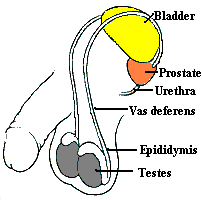Prostate Cancer
 |
Prostate cancer is a malignancy of the
prostate gland which is a chestnut size gland situated between the
urinary bladder and the male urethra. This tumor is very common and the
incidence increases with age.
A ninety
year old man has about ninety percent chance of having prostate
cancer.
Diagnosis
Diagnosis is made by finger examination by a physician. He
will suspect a malignancy when he feels a nodule on the prostate or if the
prostate feels hard. He will then do an ultrasound exam of the prostate.
|
Often he will decide to perform a biopsy. This
is done by taking needle samples of the prostate through the ultrasound guide
placed in the rectum. Pathology
The pathologist will study the specimens. He will make the diagnosis of
cancer. He will determine if this is a slow or fast growing cancer. He will
assign a number called Gleason score. A score of two is considered slow, a
score of ten will indicate a very fast growing tumor.
Metastatic Workup
It is important to know if the cancer is still contained within the
boundaries of the prostate gland. A CAT scan of the pelvis and a bone scan are
usually ordered. If these are negative that means the cancer is limited to the
prostate.
PSA is a blood test that helps us diagnose problems with the prostate. In
most instances, a PSA of less than four is considered normal. A PSA between four
and ten may be indicative of prostate cancer in 25 percent of cases. For a more
detailed discussion please see our other brochure on PSA.
Treatment
Localized disease
-
Surgery
-
Radical Retropubic Prostatectomy with pelvic lymph node
dissection: This is the best treatment as far as survival is concerned .
-
Perineal Prostatectomy: This procedure may lead to
incomplete removal of the prostate.
2. Radiation Therapy
External Beam: The results may be comparable to surgery for
up to seven years .
-
Treatment is given using a modern linear accelerator made by
either Varian or Siemens.
-
A course of treatment consists of 35 to 40 treatments.
-
Treatment is given daily, Monday through Friday, so a course
of treatment is 7 to 8 weeks.
-
Each treatment generally takes less than 1/2 an hour
-
Before a course of treatment is started there is a
consultation with an Radiation Oncologist and a process called a
"simulation". This process will map out how the beam will be
aimed at the prostate and how normal tissue will be protected. It will
take about one hour and will be performed using an X-ray machine or CT
scanner.
-
There will be a period of about 2 days before treatment
starts. During this time the protective blocks will be made and the
doses calculated.
-
After about 25 treatments the area treated is reduced to
cover just the prostate. This will normally require another simulation
process but without a 2 day break.
-
After the 25th treatment, only the smaller area (prostate)
will be treated for the remaining 10 to 15 treatments.
-
The patient does not become radioactive and can carry on
usual activities, play with the grandchildren, etc.
-
Only the pelvis is treated, not the rest of the body. Therefore, there is no nausea, vomiting or hair loss (except maybe pubic hair).
The patient may feel a little tired.
-
Symptoms during treatment often start the 3rd week.
-
Bladder irritation is the most frequent symptom
and may include urinary discomfort.
-
Rectum irritation including diarrhea and sometimes
the feeling of needing to go. Also, a little blood may be passed.
-
Symptoms can be helped by medication and usually clear up
about a month or so after treatment.
-
Patients can have sex.
-
A low residue diet is preferable during treatment
-
No need to modify other treatments or medications
3. Brachytherapy
-
This is a procedure where radioactive needles are placed in
the prostate. The long term effects of this treatment are unknown at
this time.
4. Cryotherapy
-
This consists of freezing the prostate. The problem with Cryotherapy is treating
all the cancerous tissue without harming the surrounding organs.
5. Hormonal Therapy
-
Since the prostate gland depends on its growth and maintenance on the male
hormone testosterone then medications or procedures that reduce its amount
in the body will consequently control the prostate cancer for a variable
length of time .
6. Observation
-
In elderly patients with low Gleason score, observation without any
treatment will usually be indicated. 7. Chemotherapy
8. Immunotherapy
9. High Frequency Ultrasound
|